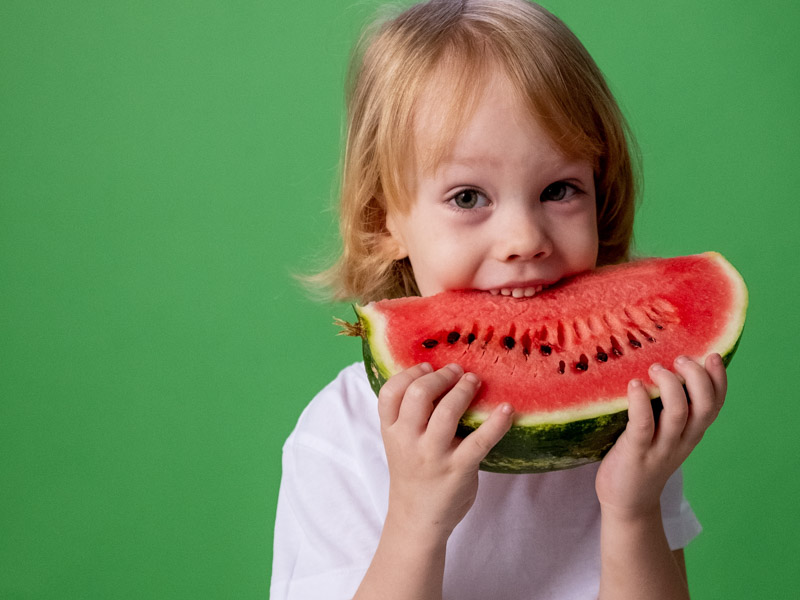Biting is a very common behavior among children ages 1.5 to 3 years of age. There are many reasons why toddlers might bite. Reasons include the following:
- Lack language skills necessary for expressing important needs or strong feelings like anger, frustration, joy, etc. Biting is a substitute for the messages he can’t yet express in words like: I am so mad at you, You are standing too close to me, I am really excited, or I want to play.
- Are overwhelmed by the sounds, light or activity level in this setting.
- Are experimenting to see what will happen.
- Need more active playtime.
- Are over-tired.
- Are teething.
- Have a need for oral stimulation.
- Attention seeking.
When biting happens: First, keep your own feelings in check. When a toddler bites, you might feel frustrated, infuriated, annoyed, embarrassed, and/or worried. All of these feelings are normal, but responding when you are in an intense emotional state is usually not a good idea. So calm yourself before you respond— take a deep breath, or do whatever works for you. Quickly, shift your attention to the child who was bitten. Often when a child bites, adults pay a lot of attention to the biter. This is usually negative attention, but it is still very reinforcing and can actually cause the biting behavior to continue, rather than stop. When adults shift their focus and energy to the child who was bitten, they clearly communicate that biting does not result in more attention. Showing concern and sympathy for the child who was bitten also teaches empathy. Take care of the hurt child first. Next, in a firm, matter-of-fact voice (but not angry or loud), say: “Biting hurts. Gentle touch.” Keep it short, simple and clear.
To prevent, reduce, and end biting: Observe the child for patterns of when the child bites. Recognize the signals that may cause them to bite. Is the child easily overwhelmed at home and/or childcare by noise, lights, crowded rooms? Then, work towards removing the triggers. Depending on your situation, teach the child the language they need, suggest strategies for sharing (set a timer), and/or add an oral sensory bin to their play area. These are just a few examples of ways to prevent more biting. Remember, learning a new behavior takes time. The child may bite again, so continue observing closely for patterns so you can intervene. It also helps to use the same words, as consistently as possible, to emphasize the message, “Biting hurts. Gentle touch.”
Working together: In a child care environment biting is an emotional and stressful experience for both the biter, the child who was bitten, and for the parents of both children. If you are advised that your child has bitten another child, or has been bitten, it’s important to take a team approach with your childcare provider to put together a plan to ensure a consistent approach is taken to solve the problem. Once you have worked out what motivates the child to bite, you can apply appropriate strategies and/or seek additional ideas and strategies that apply to your situation.
What absolutely WILL NOT work to stop biting? Shaming or harsh punishment do not reduce biting, but they do increase your child’s fear and worry—which can actually increase biting incidents. Research shows that biting your child does not reduce biting. However, it does teach your child that it’s okay to bite people when you are upset! Keep in mind that human bites can be dangerous, and biting constitutes child abuse. Identifying what triggers your child to bite and providing preventative strategies is a more effective approach.
Biting is common in babies and toddlers, but it should stop when kids are 3 to 4 years old. If it goes beyond this age, is excessive, seems to be getting worse rather than better, or happens with other upsetting behaviors, talk to your child’s doctor. Together as a team, you can find the causes and supportive ways to respond to the child.
At the Community Connections Early Learning Program, we provide a wide range of services, in partnership with families and the community to support the development of young children age birth to 3 years.
Our array of services include: Infant Massage, Parenting, Developmental Screenings, Developmental Evaluations, Vision and Hearing Screenings, Developmental therapy, Speech therapy, Motor therapy, Playgroups, and Home visiting.
Sheila Miller
Sheila is a Developmental Specialist II in our Early Learning Program.




